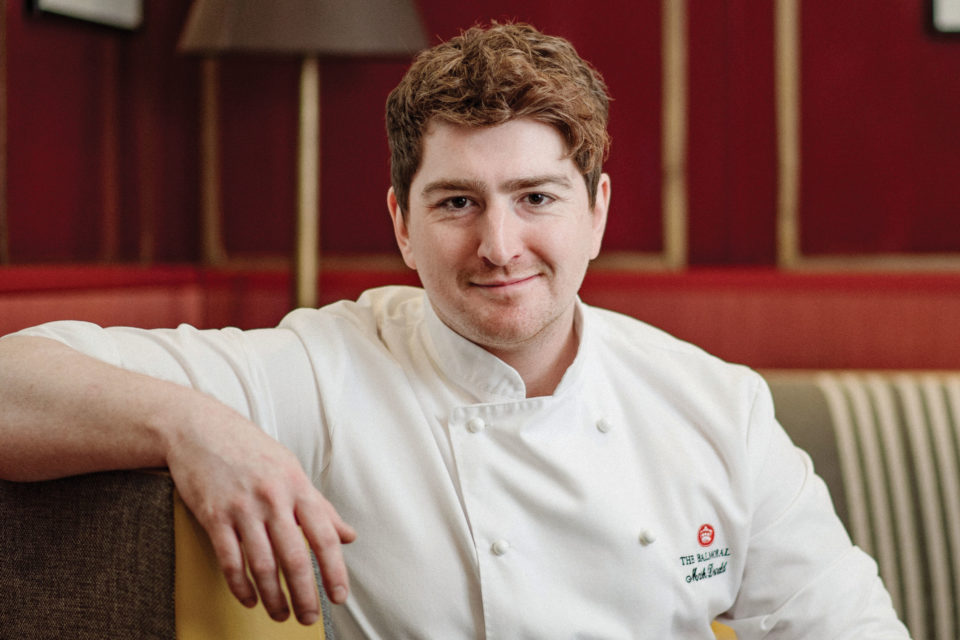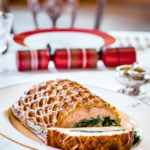Mark Donald, head chef at Number One at The Balmoral, on the world travels that have led him home to Scotland and to a Michelin star
How did it feel to retain Number One’s Michelin Star?
Totally thrilling! The whole team were delighted to have been awarded a star in the 2020 guide. The restaurant has held one since 2003 and I was honoured to have continued that legacy. I am incredibly excited for the year ahead and to continue to grow and evolve with the team.
What made you want to be a chef?
I didn’t always want to be a chef. I was always creative from a very young age and I got the grades I needed in high school to get into university. I had applied to go to acting school, but I had a job washing dishes at a place where my sister was a waitress. The chefs would go out the back door and smoke and I would call them back in when a new order came on. Eventually I stopped calling them in and started cooking myself.
Who has influenced your style of cooking?
Everyone a chef works for influences them and their own eventual cooking style. Andrew Fairlie, Claude Bosi, Brent Savage and Rene Redzepi are chefs I would consider my main influences.
You worked overseas for many years, what led you back home to Scotland?
Lots of things. I wanted to be closer to my family after having been away on and off for so long. I love travelling but couldn’t see myself running a kitchen outside of Scotland for my next role. It’s a classic case of ‘it’s where you’re from’.
What did you learn from working in other countries?
Well there’s obviously the produce and the seasons that are the biggest difference in other countries. The flora and fauna is incredibly different from country to country, a lot of which is totally unique and indigenous to that region. Exposure to different cultures, techniques and ingredients has been invaluable in my development as a cook
Has Jeff Bland’s retirement changed things at Number One?
Jeff Bland was and still is a legend around the hotel. He was so well respected by guests, colleagues, and senior management alike. He was the one who interviewed me and eventually gave me the job. After he tasted my first menu he trusted me and left me to my own devices. Several of our regulars still ask fondly after him and I always try to respect his legacy.
What’s your favourite seasonal ingredient right now?
Crown prince pumpkin. Especially in desserts.
What’s your favourite dish to cook?
Currently I like cooking a lot of Indonesian food, especially pairing it with Scottish shellfish.


Ingredients
- 1kg white onion
- 1kg red onion
- 2kg chicken stock (water or vegetable stock if vegetarian)
- 500g fennel (sliced and roasted until golden)
- 50g garlic (sliced and roasted until golden)
- 50g ginger (peeled, sliced fine)
- 500g pasta flour – tipo 00
- 50g dark malt flour
- 6 egg yolks
- 3 whole eggs
- 1kg Rooster potato flesh (hot, roasted in skin and passed through a tamis or ricer)
- 200g smoked butter
- 200g smoked milk
- Salt and smoked oil to taste
- 10 eggs
- Aged Comté (22 months)
- Chickweed
- Onion crisps
- Roscoff onion
- Cevenne onion
- Pickled thai shallot
- Chive oil
Instructions
The day before, start the onion broth. Cut the onions horizontally and roast the cut faces on a high heat with a little neutral oil. Dont be afraid to blacken them. Keep the skins on for this step as the onion will retain its shape and will roast more evenly.
Once all of the onions are roasted, peel the skin away and put in a large Dutch oven or pot and cover with the stock. Cook very slowly. At the restaurant we cover the pan and cook in the oven for 12 hours at 85ºC. Once the onions have flavoured the stock, pass the stock through a sieve into a clean, tall and slender pot. Season the broth with granny smith apple juice, salt and apple vinegar.
For the pasta, sieve the flours together on a clean work surface and make a well in the centre. Mix the eggs with the yolks and pour into the well, bringing the flour in gradually. When dough begins to form, start to bring it together with your hands and knead for ten minutes on the bench. This can also be done with a food mixer. Once the dough is smooth, cover and rest in the fridge.
For the filling, add the hot potato to a small pan and put on the stove at a low to medium heat. Add the milk and butter gradually until well combined being careful the mixture never catches or sticks. Season to your taste with salt and smoked oil. Pass the mixture again through a sieve or tamis. Put the mash into a piping bag and allow to cool to room temperature.
To make the ravioli, crack 10 eggs into a bowl, set aside. Lightly dust a clean work surface with pasta flour and roll the pasta to the thinnest setting on a pasta machine.
Pipe the mash onto the pasta in the shape of a cartoon beehive around 1.5 inches high leaving a space in the centre for your yolks. Repeat 9 times along the sheet.
Carefully, separate each yolk from the white of the egg and slide into the hole in each mash cup. Pipe the remaining mash on top of each yolk so the yolks are no longer seen. This will also protect them during cooking so they are evenly cooked and runny.
Roll another sheet of pasta out and cover the little potato protected egg yolk beehives. Press the pasta down and around each egg, taking care not to break the structure you have just made onto the sheet underneath, forming 10 raviolis. Be sure to expel any air pockets from the ravioli otherwise they will burst in the water as they heat.
Cook the ravioli for 4 minutes 30 seconds in a pan of heavily seasoned, almost boiling water. Remove from the pan and place a thin slice of comte on top. Blowtorch the cheese to melt and caramelise. Place in a bowl and arrange one petal each of cooked roscoff and cevenne onions that have been seasoned, lightly roasted and cooked in their skins. Finally place 3 thai shallots around the plate and garnish with onion crisps and chickweed. In a small pan, warm the onion broth and chive oil together and pour into the bowl.



